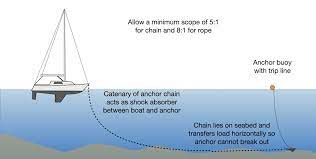I believe that if you spend enough nights and anchor, at one point or another you’ll drag. I heard a cruiser say once that there are two kinds of cruisers — those who have stories to tell about their anchor dragging, and those who have lies to tell about never dragging.
We’re in the first group. We have a story to tell. The experience taught me a lot—hopefully enough to assure that we don’t develop more dragging stories to tell in the future.
It was early in our sailing life. We’d anchored dozens of times at the point this incident occurred, but certainly not hundreds of times. It was early June, and we were exploring Mobjack Bay in the lower Chesapeake. We dropped the hook in about 10’ of water, and the bottom was reported to be silt and mud. I put out about 50’ of scope with the bridle but no snubber—at this point I didn’t understand the value of the snubber.
The first day was beautiful, with light winds and a bluebird sky. Day two was a repeat of day one, just more hot and humid. That second evening, thunderheads were developing to our west, so as the sun set I stayed up in the cockpit to watch the storms in case they were going to visit us. They were to our west and our northwest, and I assumed they’d continue to move NE, leaving us to their south. So I finished my drink, confirmed that the tiny south breeze had us pushed to the north of our anchor, and headed down to join Christine in bed.
She sleepily asked about the storms, and I said that I thought we were safe—the storms should pass to our north. What I failed to do was look at radar on the weather. If I had done that, I would have realized that the storms were moving SE, not NE, and we were directly in their path.
About 30 minutes after my head hit the pillow, a strong wall of wind from the north pushed Harvest Moon suddenly and quickly southward. I felt the wind push us hard and sat up. Then I heard the pop as we hit the end of our rode suddenly. Looking back, I’m sure that this sudden snatch load popped the anchor out of the seafloor.
We were being pushed out of 10’ depth and across 20’ depth now, so there was no way our 50’ of scope was going to allow that anchor to set as we drug it southward with us. By this time I was up in the cockpit and had started the engine. At least the dragging anchor was keeping us pointed generally into the wind, so I was able to use the engine in forward gear to slow our drag down through the worst of the wind, which only lasted about 20 or 30 minutes.
There were five sailboats anchored in that creek, and all but one of them was dragging. The wind was whipping me with slashing rain at the helm in the cockpit as we sawed back and forth in the wind, the bow hanging on to the dragging anchor.
When it was all said and done, two sailboats had drug their anchor across the rode of the one sailboat that wasn’t dragging. Two of them had done a bit of crashing and fending off each other as well. After the winds died, they were able to pull their anchors and return to the spots where they had anchored in the first place. We hadn’t fouled with anyone, and had stayed safely out of the fray, so we quietly skulked off to our corner in the dark.
The two sailboats that had fouled and bumped and crashed were out of the anchorage at first light. Once I saw that the couple on the boat that hadn’t dragged were up and about, I dinghied over to them to ask if all was okay. They were fine, and had sustained no damage. I told them I was impressed that they had not dragged at all, and asked about their ground tackle.
Turns out they had just bought the boat, and this was the first time they’d ever anchored. Ever. In any boat. They had no idea what they were doing. They had a CQR anchor that was barely big enough for their boat, (most cruisers scoff at the CQR design as ineffective,) and their rode was all rope—no chain at all. They said that since they didn’t know what they were doing, they had put out all 150’ of their rope rode. They hadn’t budged behind their 15:1 scope, while those of us with superior anchor designs and sizing, as well as chain rode, dragged across the anchorage.
The moral of the story that I took with me was this: Additional scope will hide a lot of other shortcomings in the anchoring equation. Of all the bits and pieces of that equation, adequate scope might just be the most important.
